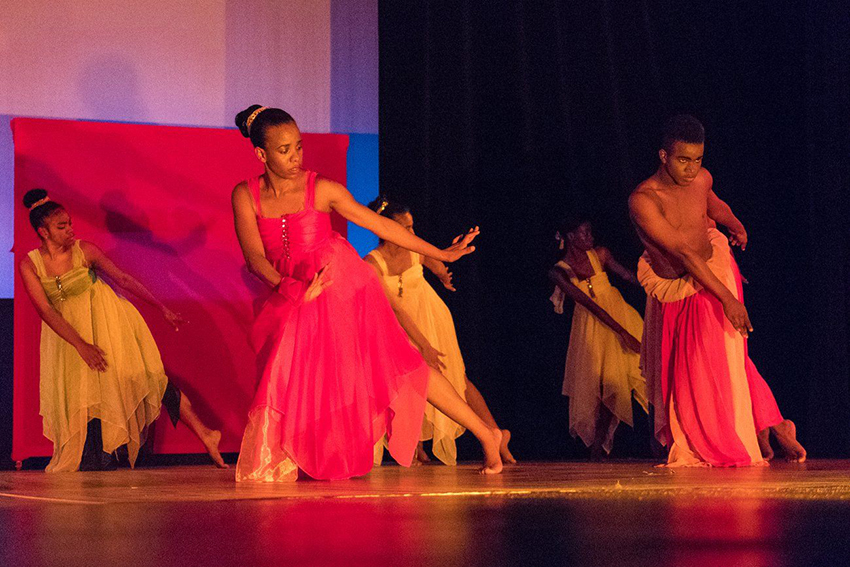 The National Dance Company staged its annual production “Christmas Funtasia” a week ago. This production was a reminder of traditions, theatrical and otherwise, at the Christmas season. It is a Dance Company tradition to stage this show every year in December to have fun with the audience as befitting the season, but also to reflect on and dramatise the many customs associated with Christmas.
The National Dance Company staged its annual production “Christmas Funtasia” a week ago. This production was a reminder of traditions, theatrical and otherwise, at the Christmas season. It is a Dance Company tradition to stage this show every year in December to have fun with the audience as befitting the season, but also to reflect on and dramatise the many customs associated with Christmas.
These traditions are several and varied, old and recent, demonstrating Christmas as a theatrical festival, to add to the other categories in which it falls. Christmas Funtasia dramatized the Christmas story, the mythology that evolved around it and its popular offshoots, the Christian religion within which it originated, and the spirit of the festival – its meaning and messages for mankind.
But prevalent in it all was the theatre. Different kinds of dances were exhibited, including classical, a touch of ballet, and folk, such as the parang and their relationships to Christmas were in evidence in the production. They strengthened the resonance of theatre.
There are many theatrical traditions. In Jamaica there is one that has survived and even deepened. This is the beginning of a new theatre season on Boxing Day. Traditionally, the annual Jamaica Pantomime, a musical, opens every year on Boxing Day (December 26), following a practice that is more than 70 years old. The Pantomime has stuck to that unstintingly. What is now known as The LTM Jamaica Pantomime Musical evolved from the ancient English pantomime, a folk play performed at Christmas since the Middle Ages and taken to Jamaica and performed annually since 1942. It is a musical play in which a folk or a fairy tale is used to form a drama. There are certain characteristics, such as that it has a romantic sub-plot and two romantic leads – the male lead is always played by a woman. There are stock characters, including a Dame, who is a female character played in very hilarious fashion and low farce, by a man. There is also a villain.
Other plays in Kingston then took up the Boxing Day opening practice because, according to the Jamaica Observer, many members of the potential audience would look to the theatre for new plays in the holiday season. The custom of opening on Boxing Day has spread to the major theatre producers including Centrestage and Basil Dawkins. A few years ago, there were six plays opening on that day, in addition to another opening on Christmas Day itself, and one other on December 27.
These have resonances to old traditions in the Caribbean, such as Vaudeville. A part of which were the annual Christmas Morning Concerts, always held in a cinema house but fading away perhaps just after 1970. The Christmas traditions that have to do with theatre go back centuries, even to the very origins of the festival.
It started at the rise of the Christian religion itself. Around 5 AD western theatre in Europe faded away. Christianity played a part in that because it disapproved of the Roman drama at the time, which it deemed immoral. The Christmas festival itself which celebrated the birth of Christ had its own origins in old Roman festivals, such as Saturnalia and a number of pagan celebrations and beliefs. There is a Christmas Carol – “The Holly and The Ivy” – which celebrates the birth of Jesus but harks back to ancient spiritual belief in and worship of evergreen plants such as those. Many of the contributing traditions, beliefs, mythologies and festivals were theatrical, or were manifested in dramatic ritual or symbolic representation.
Christmas is a religious festival – the most important of the Christian festivals since it focuses on the significance of the birth of the messiah. Like all religious festivals it starts off in belief, worship and spiritual ritual. But it has since evolved to also become many other types of festival. It is traditional, it is cultural, popular and commercial. Above all, today, it is popular. It is the most popular festival in all the world, observed by non-Christian countries and cultures everywhere on all continents. In fact, it is the most popular festival of all types. It has even developed its own secular mythology and its own secular culture. These are practiced globally and have nothing to do with the holy birth, but are more than anything, driven by commerce, entertainment and revelry.
Along with the long rise of Christianity from its origins in Rome, and of the Roman Catholic Church, has been the rise of theatre and the deployment of the theatrical. Apart from those things that were theatrical and symbolic that attended the development and the widening of Christmas in the Middle Ages (or mediaeval times), Christianity was responsible for the rebirth of drama.
The drama that developed as we know it today in the western world originated in the Roman Catholic Church. A part of that was the development of Christmas theatre. A number of theatrical forms evolved during the C9th to the C12th AD. The priests saw the need to educate the serfs – working people and peasants – who were members of their congregations but who were not able to read the Bible. They wanted ways of teaching the scriptures and principles of Christianity and began to use drama to do it. Liturgy developed into liturgical drama, which they read from the pulpit; they wrote dramatic scripts telling stories from the Bible. These included miracle, mystery and passion plays, with such sub-groups as Quo Vadis and Quem Quaeritis? These were first written in Latin.
Some scripts would begin with the question Quo Vadis? (where are you going?) and in other instances Quem Quaeritis? (whom do you seek?). These were performed during mass. The first stage was the altar. The priests would lead and then the congregation would join in the performance and it all took place at the altar and in the cathedral. They grew into full plays and theatre within the church, then outgrew the church and evolved into more complex, long-lasting forms.
Relating directly to Christmas were the Nativity Plays, one of the types in that group. These were plays which told the story of the nativity – the birth of Christ. From those mediaeval origins, nativity plays have survived to the present day. They are performed everywhere, in and out of church by various groups, mainly in amateur theatre, but the professional theatre has long been duly influenced and many forms of this kind of play have been produced. There is even a going back to origins in that this drama is often performed or scripts read out in church as the priests did it in those days.
There were also developments out of the church building. A group of plays called the Shepherds’ Plays evolved. These also told the story of the miraculous birth, but mainly from the point of view of the shepherds. The main characters in these were shepherds who, according to the story, were very important participants. They were foretold about the nativity and were able to go to the birthplace. Additionally, they were part of the setting – Jesus born in a manger with sheep nearby, and the symbolism of the good shepherd and the flock. More than that they displayed the motif of humility – the most powerful king being born in a very humble environment and among such classes of people as shepherds.
Even where there are not live performances there are tableaux. These are visual depictions of scenes from the nativity, often carved out in lifelike images. They are found at the altar in several church buildings and in many other locations at Christmas time. Interestingly, this scene is also commonly assembled at locations in several large cities in China during the season.
Christmas and theatre are also linked in ways outside of religion. There is a folk form in Europe, whose origins may also be mediaeval, called mumming. This is a practice in which small groups of villagers in costume and disguises, would get together at Christmas, assemble a performance, and walk around the village from house to house performing it. They are treated with refreshments. Fairly similar to this is wassailing in which the groups do the same thing, but they would entertain the households with the singing of carols.
The tradition of house-to-house mummery is also found in Caribbean theatrical traditions. There is a faded street performance appearing in the island of St Kitts during the season. It is a masquerade tradition in which costumed masqueraders process along the street stopping at points to perform. Their plot is mostly derived from old British battles including St George, the Turkish Knight, a pretender to the throne and a battle. These are narrated and acted out.
House-to-house mummery is also part of the parang, a musical tradition of Trinidad and Tobago. The parang belongs to a culture in which villagers conform to certain patterns of behaviour including the giving of gifts, music and dance known to have developed on cocoa plantations. The parang is the only known Caribbean folk performance at Christmas that actually celebrates the birth of Christ. There is a whole corpus of songs at the core of the performance, all performed in Spanish, which glorify the Virgin Mary and other related themes. Parang performers are known to process on Christmas morning from house to house in the village and there are exchanges of food and drinks.
Now extinct, is another masque formerly seen in St Lucia. This is Papa Djab – Flavier the White Devil. There was a host of devils (djab-djab) – patois for “diable” (French; devil), appearing on the streets of Castries. They were the sons of Flavier, very rebellious, who quarrelled and fought among themselves, killing each other. Flavier or Papa Djab, was very distressed by this, but would perform his magic to bring them back to life. While there is no directly stated Christmas theme, there is rebirth, forgiveness and love which are usually part of the Christmas message. This was a ‘doctor play’ of the type known to have been performed in the Jamaican jonkannoo and the Guyanese masquerade, but it was an independent masque.
The whole story of Jesus is itself a dramatisation of the beliefs and principles of Christianity. These involve sacrifice, forgiveness, the gift of life and rebirth. These may be found in aspects of the masquerade but are not themes in the range of Caribbean folk performances at Christmas, except for the parang.









